Topics
Category
Era
Minnesota State Fair, 1917
Since its founding in 1859, the Minnesota State Fair had been an essential yearly tradition in the agricultural state. However, after the United States entered World War I in 1917, the fair took on an entirely new significance. Organizers reframed the event as a “Food Training Camp” that showed Minnesotans how to produce and conserve resources vital to the Allied war effort.
After the United States declared war on Germany on April 6, 1917, some believed that the fair should be cancelled. Gasoline was rationed. Many believed that the railroads, needed to transport people and livestock to the fair, should be used by the military instead. Due to newly imposed food restrictions on sugar, wheat, and meat, many popular cooking and baking contests could not go on as usual. In spite of these concerns, fair organizers argued that it was vital that the fair be held as planned.
Agricultural Society publicist Ray Speer proposed the idea of the fair as a “food training camp.” It was more important than ever, he argued, to introduce Minnesotans to new agricultural products, livestock, and farm machinery. The beginning of the war in 1914 had caused major disruptions in the European food supply. When the United States joined the Allies, producing enough surplus food to feed American soldiers as well as Europeans became a priority. The state fair, Speer claimed, would help Minnesota farms produce more. It would also teach all Minnesotans new food conservation and preservation techniques.
The Agricultural Society’s view prevailed, and organizers went to work planning the event. Promoters were careful to emphasize that every Minnesotan had a role to play in the war effort as well as at the fair. Cartoon advertisements, printed in newspapers across the state, emphasized how every aspect of the fair could be linked to Minnesota’s support of the war.
The fair was held between September 3 and September 8 at the State Fairgrounds in St. Paul (later Falcon Heights). It showcased a multitude of new plants, animals, and methods of farming. Agricultural scientists displayed new varieties of corn, wheat, and other crops that could result in larger harvests per acre. Farmers were encouraged to raise livestock that yielded more meat. Developing stronger breeds was of special concern during the fair, since much of Europe’s livestock had been destroyed in the war and would need to be replaced when it was over.
Farm machinery played a more important role than it had at past fairs. Though agricultural machines had been exhibited since the 1860 fair, the 1917 fair featured the latest and most efficient models. Though there were 175,000 farms in Minnesota alone, there were fewer than sixteen thousand tractors in the entire country. With increased demand for food and with the Army taking both men and horses from Minnesota farms, there was more incentive than before to create a modern, mechanical farm.
While agricultural production was central to the 1917 fair, organizers made it clear that all Minnesotans were needed to participate in the war effort. Classes in gardening, canning, and preservation offered Fair attendees ways to help raise the state’s food production. Children were encouraged to form clubs to raise everything from potatoes to chickens. Cooking demonstrations helped home cooks cope with the schedule of increasingly wheatless and meatless meals.
The fair also highlighted new fashions and sewing techniques that wasted less fabric. Organizers replaced fancy sewing contests with more utilitarian ones. The Red Cross, YMCA, and YWCA held outreach activities at the Fair, all emphasizing how men women and children could support the troops. Booths collected money for Liberty Loans and stalls displayed handicraft projects by disabled veterans.
Much of the entertainment at the 1917 fair was influenced by the war as well. Army officers staffed recruiting booths and presented displays of horsemanship. Sporting contests highlighted the athletic ability essential to the men who might enlist. A nightly show at the Grandstand featured a cast of three hundred reenacting major battles of the Western Front complete with a massive fireworks display.
Despite early concerns that it should not be held at all, the 1917 fair broke all attendance records to that date. It drew 116,000 people on Labor Day alone and a total of 382,405 across its seven-day run.
Bibliography
“About the State Fair.” New Ulm Review, September 12, 1917.
http://chroniclingamerica.loc.gov/lccn/sn89081128/1917-09-12/ed-1/seq-3/#date1=1917
Eighmey, Rae Katherine. “‘Food Will Win the War’: Minnesota Conservation Efforts, 1917–1918.” Minnesota History 56, no. 7 (Fall 2005): 272–286.
http://collections.mnhs.org/MNHistoryMagazine/articles/59/v59i07p272-286.pdf
“Food or Defeat: The Importance of Minnesota’s Great State Fair Should Not Be Underestimated This Year.” Western Magazine 10, no. 2 (August 1917): 38–44.
Marling, Karal Ann. Blue Ribbon: A Social and Pictorial History of the Minnesota State Fair. St. Paul: Minnesota Historical Society Press, 1990.
“Minnesota Surpasses All State Fair Records.” Wallace’s Farmer, September 14, 1917.
http://idnc.library.illinois.edu/cgi-bin/illinois?a=d&d=WAF19170914.2.38#
“Officers of the United States Army Will Appear.” Cook County News-Herald, September 5, 1917.
“Red Lake Agency News.” Red Lake News, October 1, 1917.
http://chroniclingamerica.loc.gov/lccn/sn90059061/1917-10-01/ed-1/seq-1/
“Red Lake Indian Girls Are In Breadmaking Contest." Bemidji Daily Pioneer, August 27, 1917.
http://chroniclingamerica.loc.gov/lccn/sn86063381/1917-08-27/ed-1/seq-1/
“Red Lake Indian Wheat Prize Winner at State Fair.” Bemidji Daily Pioneer, September 6, 1917.
http://chroniclingamerica.loc.gov/lccn/sn86063381/1917-09-06/ed-1/seq-1
“Wonderful Entertainment Program Offered by Minnesota State Fair.” Bemidji Daily Pioneer, August 27, 1917.
http://chroniclingamerica.loc.gov/lccn/sn86063381/1917-08-27/ed-1/seq-2/
Related Resources
Primary
“Food Training Camp Volunteers Called to the Colors!” Bemidji Daily Pioneer, August 18, 1917.
“Interest Increases in Food Camp.” Warren Sheaf, August 1, 1917.
http://chroniclingamerica.loc.gov/lccn/sn90059228/1917-08-01/ed-1/seq-3/
“Livestock Show Will Be Big One” St. Paul Appeal, August 18, 1917.
http://chroniclingamerica.loc.gov/lccn/sn83016810/1917-08-18/ed-1/seq-4/
“Machinery Show Grows.” St. Paul Appeal, September 1, 1917.
http://chroniclingamerica.loc.gov/lccn/sn83016810/1917-09-01/ed-1/seq-2/
Minnesota State Agricultural Society. Recommendations to the 1917 Minnesota Legislature by the Minnesota State Agricultural Society. [MN]: N.p., 1917.
Minnesota State Fair Official Auto Race Program Collection, 1913–1947
Pamphlet Collection, Minnesota Historical Society, St. Paul
Description: Includes programs for auto races held at the Minnesota State Fair.
Speer, Ray P. “The 1918 Minnesota State Fair: This Year’s Event of Vital Importance to the Northwest.” Western Magazine 12, no. 2 (August 1918): 38–43.
“Women and Children Important.” Little Falls Herald, August 24, 1917.
Secondary
Eighmey, Rae Katherine. Food Will Win the War: Minnesota Crops, Cooks, and Conservation During World War I. St. Paul: Minnesota Historical Society Press, 2010.
Speer, Ray P. Minnesota State Fair: the History and Heritage of 100 Years; A Brief History of the Early Years of The Minnesota Agricultural Society and a More Complete History of the Years From 1910 to 1964. Minneapolis: Argus Publishing, 1964.
Related Images
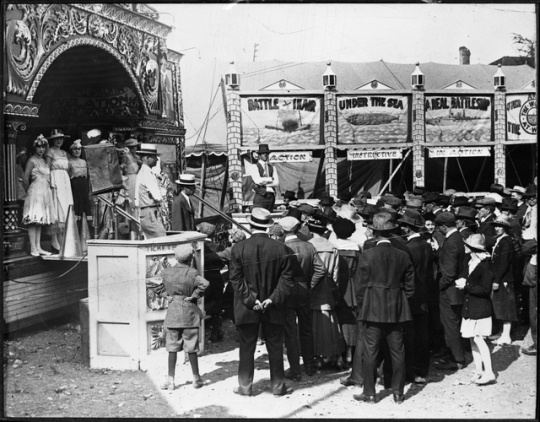
Sideshow at 1917 Minnesota State Fair
Sideshows at the Minnesota State Fair, 1917.
Public domain
Holding Location
Articles
More Information
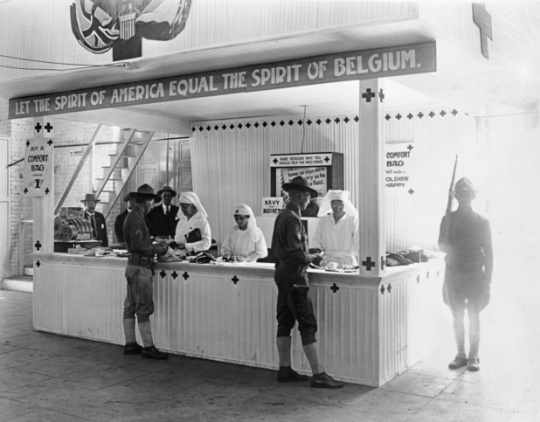
Red Cross booth at 1917 Minnesota State Fair
Red Cross booth ("Let the Spirit of America Equal the Spirit of Belgium") at the 1917 Minnesota State Fair.
Public domain
Holding Location
Articles
More Information
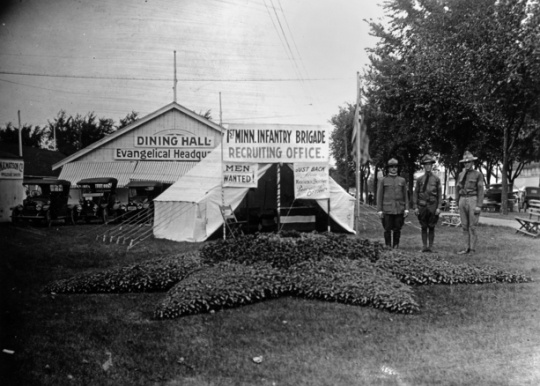
Recruiting tent for the First Minnesota Infantry Brigade at the Minnesota State Fair
Recruiting office for the 1st Minnesota Infantry Brigade, 1917 Minnesota State Fair.
Public domain
Holding Location
Articles
More Information
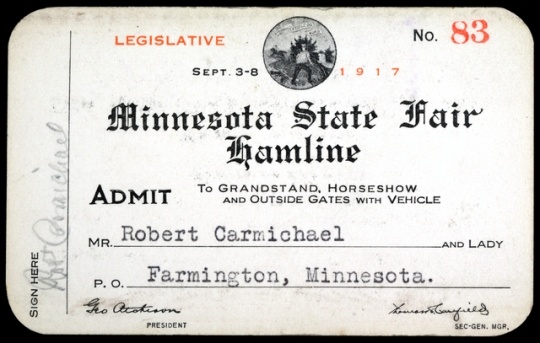
Pass for the 1917 Minnesota State Fair
Minnesota State Fair pass, 1917.
All rights reserved
Holding Location
Articles
More Information
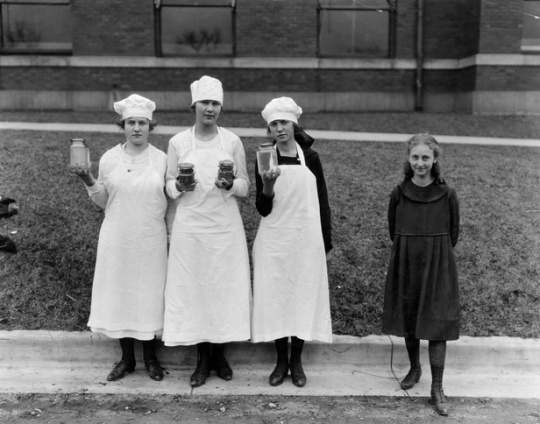
Canning champions at the 1917 Minnesota State Fair
Winners of the 1917 Minnesota State Fair girls’ canning competition.
Public domain
Holding Location
Articles
More Information
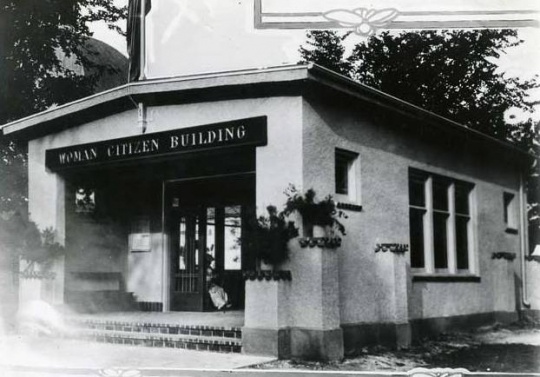
Woman Citizen Building at the 1917 Minnesota State Fair
Woman Citizen Building, 1917 Minnesota State Fair.
Public domain
Holding Location
Articles
More Information
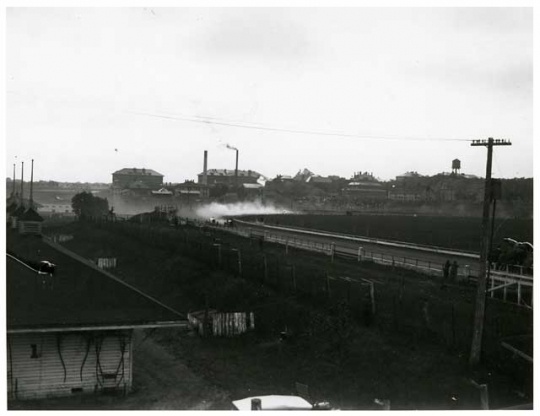
Auto race at 1917 Minnesota State Fair
Auto race at the 1917 Minnesota State Fair.
Public domain
Holding Location
Articles
More Information
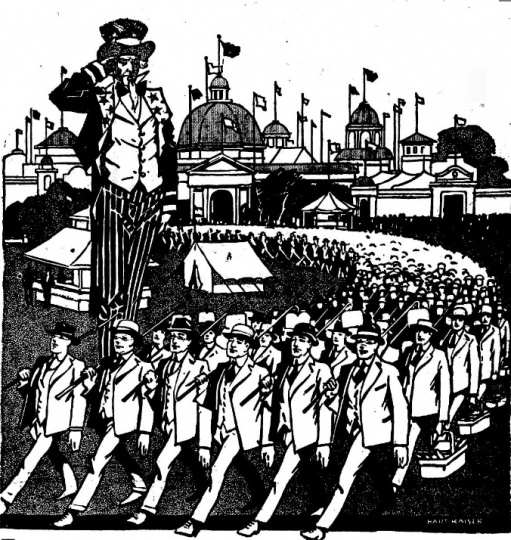
Food Training Camp Advertisement
Newspaper cartoon by Hart Kaiser advertising the Food Training Camp at the Minnesota State Fair. Image is from the Bemidji Daily Pioneer, August 18, 1917.
Public domain
Holding Location
Articles
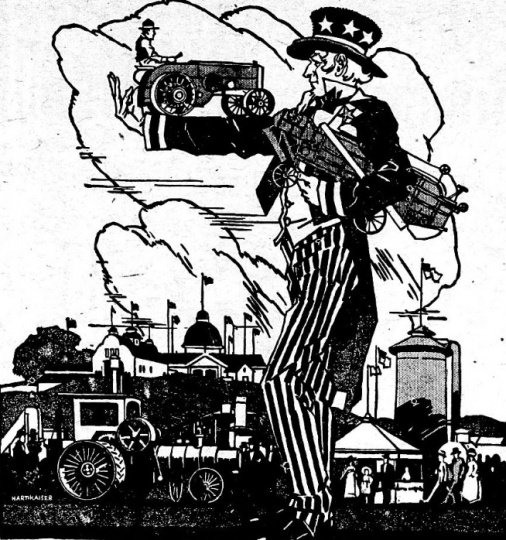
Advertisement for Food Training Camp
Newspaper cartoon advertising the Food Training Camp at the Minnesota State Fair. Image is from the St. Paul Appeal, August 4, 1917.
Public domain
Holding Location
Articles
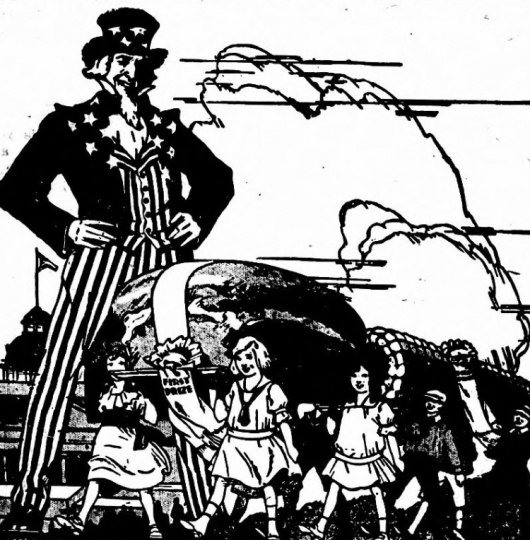
Food Training Camp cartoon for children
Newspaper cartoon advertising the involvement of children in the Food Training Camp at the Minnesota State Fair. Image is from the Willmar Tribune, August 15, 1917.
Public domain
Holding Location
Articles
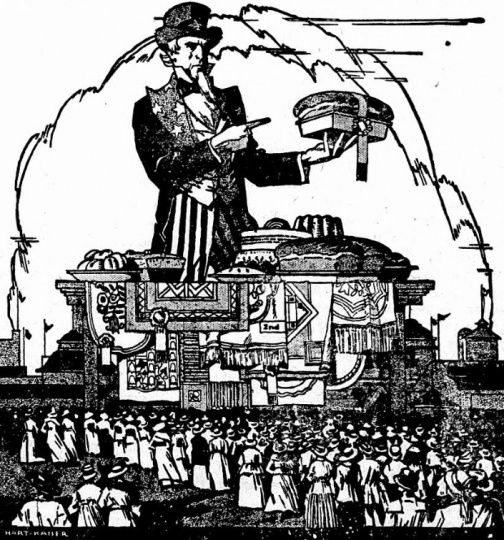
Food Training Camp advertisement for women
Newspaper cartoon advertising the involvement of women in the Food Training Camp at the Minnesota State Fair. Image is from the New Ulm Review, August 8, 1917.
Public domain
Holding Location
Articles
Related Articles
Turning Point
On its first full day on September 3, the fair draws 116,000 people, paving the way for the event to break the seven-day total attendance record of 374,128 set in 1912.
Chronology
April 6, 1917
Summer 1917
Septem-ber 2, 1917
Septem-ber 3, 1917
Septem-ber 4, 1917
Septem-ber 5, 1917
Septem-ber 6, 1917
Septem-ber 7, 1917
Septem-ber 8, 1917
Bibliography
“About the State Fair.” New Ulm Review, September 12, 1917.
http://chroniclingamerica.loc.gov/lccn/sn89081128/1917-09-12/ed-1/seq-3/#date1=1917
Eighmey, Rae Katherine. “‘Food Will Win the War’: Minnesota Conservation Efforts, 1917–1918.” Minnesota History 56, no. 7 (Fall 2005): 272–286.
http://collections.mnhs.org/MNHistoryMagazine/articles/59/v59i07p272-286.pdf
“Food or Defeat: The Importance of Minnesota’s Great State Fair Should Not Be Underestimated This Year.” Western Magazine 10, no. 2 (August 1917): 38–44.
Marling, Karal Ann. Blue Ribbon: A Social and Pictorial History of the Minnesota State Fair. St. Paul: Minnesota Historical Society Press, 1990.
“Minnesota Surpasses All State Fair Records.” Wallace’s Farmer, September 14, 1917.
http://idnc.library.illinois.edu/cgi-bin/illinois?a=d&d=WAF19170914.2.38#
“Officers of the United States Army Will Appear.” Cook County News-Herald, September 5, 1917.
“Red Lake Agency News.” Red Lake News, October 1, 1917.
http://chroniclingamerica.loc.gov/lccn/sn90059061/1917-10-01/ed-1/seq-1/
“Red Lake Indian Girls Are In Breadmaking Contest." Bemidji Daily Pioneer, August 27, 1917.
http://chroniclingamerica.loc.gov/lccn/sn86063381/1917-08-27/ed-1/seq-1/
“Red Lake Indian Wheat Prize Winner at State Fair.” Bemidji Daily Pioneer, September 6, 1917.
http://chroniclingamerica.loc.gov/lccn/sn86063381/1917-09-06/ed-1/seq-1
“Wonderful Entertainment Program Offered by Minnesota State Fair.” Bemidji Daily Pioneer, August 27, 1917.
http://chroniclingamerica.loc.gov/lccn/sn86063381/1917-08-27/ed-1/seq-2/
Related Resources
Primary
“Food Training Camp Volunteers Called to the Colors!” Bemidji Daily Pioneer, August 18, 1917.
“Interest Increases in Food Camp.” Warren Sheaf, August 1, 1917.
http://chroniclingamerica.loc.gov/lccn/sn90059228/1917-08-01/ed-1/seq-3/
“Livestock Show Will Be Big One” St. Paul Appeal, August 18, 1917.
http://chroniclingamerica.loc.gov/lccn/sn83016810/1917-08-18/ed-1/seq-4/
“Machinery Show Grows.” St. Paul Appeal, September 1, 1917.
http://chroniclingamerica.loc.gov/lccn/sn83016810/1917-09-01/ed-1/seq-2/
Minnesota State Agricultural Society. Recommendations to the 1917 Minnesota Legislature by the Minnesota State Agricultural Society. [MN]: N.p., 1917.
Minnesota State Fair Official Auto Race Program Collection, 1913–1947
Pamphlet Collection, Minnesota Historical Society, St. Paul
Description: Includes programs for auto races held at the Minnesota State Fair.
Speer, Ray P. “The 1918 Minnesota State Fair: This Year’s Event of Vital Importance to the Northwest.” Western Magazine 12, no. 2 (August 1918): 38–43.
“Women and Children Important.” Little Falls Herald, August 24, 1917.
Secondary
Eighmey, Rae Katherine. Food Will Win the War: Minnesota Crops, Cooks, and Conservation During World War I. St. Paul: Minnesota Historical Society Press, 2010.
Speer, Ray P. Minnesota State Fair: the History and Heritage of 100 Years; A Brief History of the Early Years of The Minnesota Agricultural Society and a More Complete History of the Years From 1910 to 1964. Minneapolis: Argus Publishing, 1964.












